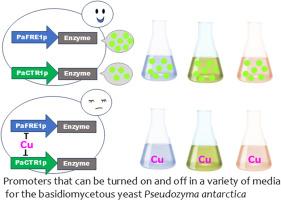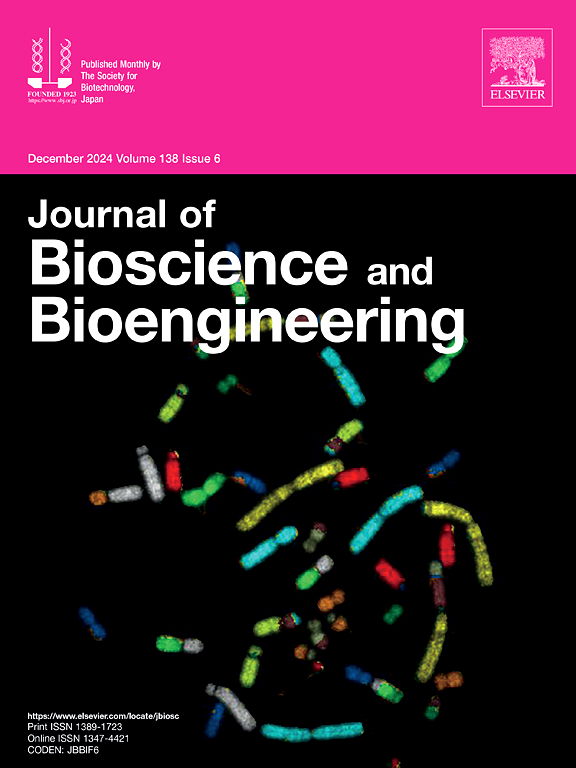新的南极假酶启动子表现出稳定的葡萄糖介导的激活和铜介导的对侧翼基因的抑制。
IF 2.9
4区 生物学
Q3 BIOTECHNOLOGY & APPLIED MICROBIOLOGY
引用次数: 0
摘要
南极假酶是一种以木糖为诱导剂和碳源产生塑料降解酶(PaE)的叶定殖担子菌酵母。值得注意的是,葡萄糖是一种容易获得的碳源,尚未用于PaE的生产。这里,我们确定了两个p .南极洲的倡导者在高水平稳定的PaE诱导基因转录与葡萄糖在媒体常用的酵母,以及评估补充铜的影响。通过微阵列分析,鉴定出葡萄糖培养中高表达的前5个基因,并通过报告子实验评估其启动子活性。第一和第二基因与酿酒酵母基因组中调控铜摄取的FRE和CTR具有较弱的相似性,因此它们作为启动子具有互反序列,分别为PaFRE1和PaCTR1,在南极p.a ntera染色体上相距903个核苷酸。p .南极时生长在三种常见的媒体利用葡萄糖作为碳源,PaFRE1和PaCTR1诱导高和稳定表达和产生更多不同的人工荧光素酶和内源性PaE肌动蛋白的高表达启动子。此外,添加铜抑制了PaFRE1和PaCTR1启动子的活性。总之,这项研究表明,这些p .南极启动子可用于生产各种蛋白质如PaE。本文章由计算机程序翻译,如有差异,请以英文原文为准。

Novel promoter of Pseudozyma antarctica exhibits stable glucose-mediated activation and copper-mediated suppression of flanking genes
Pseudozyma antarctica is a leaf-colonizing basidiomycetous yeast that produces a plastic-degrading enzyme (PaE) using xylose as an inducer and carbon source. Notably, glucose, a readily available carbon source, has not been utilized for PaE production. Herein, we identified two promoters of P. antarctica for stable induction of PaE gene transcription at high levels in commonly used yeast media with glucose, along with assessing the effect of copper supplementation. Through microarray analysis, the top five genes with high expression in glucose cultures were identified and their promoter activities were evaluated by reporter assay. The first and second genes were located 903 nucleotides apart on the P. antarctica chromosome and shared reciprocal inverted sequences as promoters, namely PaFRE1 and PaCTR1, respectively, owing to their weak similarity to FRE and CTR in Saccharomyces cerevisiae genome, which regulate the copper uptake. When P. antarctica was grown in three common media using glucose as a carbon source, both PaFRE1 and PaCTR1 induced high and stable expression and produced more heterologous artificial luciferase and endogenous PaE than that by the highly expressed actin promoter. Additionally, the activities of PaFRE1 and PaCTR1 promoters were suppressed by copper addition. Altogether, this study shows that these P. antarctica promoters can be used to produce various proteins such as PaE.
求助全文
通过发布文献求助,成功后即可免费获取论文全文。
去求助
来源期刊

Journal of bioscience and bioengineering
生物-生物工程与应用微生物
CiteScore
5.90
自引率
3.60%
发文量
144
审稿时长
51 days
期刊介绍:
The Journal of Bioscience and Bioengineering is a research journal publishing original full-length research papers, reviews, and Letters to the Editor. The Journal is devoted to the advancement and dissemination of knowledge concerning fermentation technology, biochemical engineering, food technology and microbiology.
 求助内容:
求助内容: 应助结果提醒方式:
应助结果提醒方式:


